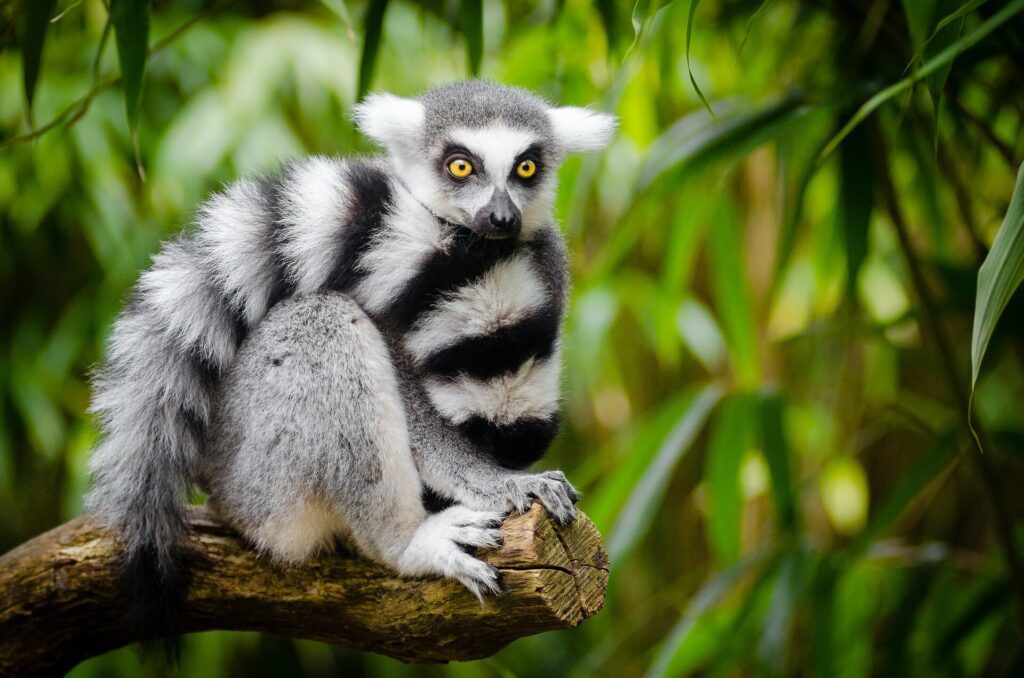Credit: Pixabay/CC0 Public Domain
Three hundred miles off the southeastern coast of Africa, Madagascar is a land of mystery. There is such a rich diversity of vertebrates found only on the island that is so unlike anything seen elsewhere in the world that any evolutionary biologist has to wonder—how did they get there and when?
Lemurs are only found here. A primate separated evolutionarily from apes and monkeys by more than 50 million years, lemurs have diversified into about 111 species, making up a third of all primate species in the world.
The fossa, a distant cousin of the mongoose, is an apex island predator that has convergently evolved to have more cat-like traits and appearance, filling in the missing felines biome niche.
Then there are the 36 species of tenrec, which can range in appearance from a tiny shrew-like mouse to a large tailless possum, hedgehog and mole lookalikes, filling out several convergent evolutionary niches usually held by more genetically diverse creatures.
A pair of researchers at the University of Hong Kong in China and Temple University in Philadelphia decided to join the debate about just how the island became populated by so many unusual creatures. They detail their research findings in a paper, “The colonisation of Madagascar by land-bound vertebrates,” published in the journal Biological Reviews.
Three basic ways are possible, with versions of each having been postulated in the past.
Plate tectonics, meaning the land-bound creatures endemic to Madagascar evolved there, separated from the rest of the animal kingdom since the island split off from the ancient Gondwana supercontinent. Since this split began 170 million years ago, understanding when species evolved away from shared ancestors of other vertebrates eliminates all but a few of Madagascar’s inhabitants from this possibility.
Another is a land bridge spanning all or most of the way from Africa to Madagascar, allowing creatures to simply wander over. This might be aided by lower sea levels during ice ages or continental drift as land masses have moved over millions of years. As an example, all the marsupials of Australia walked there from South America when the two continents were further south and connected by Antarctica. However, the geologic record does not seem to support a period when the sea floor around Madagascar would be exposed, nor any string of islands above the surface to shorten the distance.
This leaves arrival by sea, floating, swimming or rafting on vegetation carried by the currents.
The team looked for evidence to build arrival time windows for 26 of Madagascar’s land vertebrate clades—16 reptiles, five mammals, and five amphibians. The approach was designed to highlight the method of arrival by reconstructing the temporal influx patterns. If species arrived together in a few windows of opportunity, it would suggest a land bridge was available. If instead the colonization events looked randomly dispersed through time, getting washed ashore by sea currents might be a better explanation.
The resulting colonization maps appeared temporally random with no temporal concentrations.
This places the biological signals in agreement with the leading geological evidence, as well as the taxonomic composition of the fauna, in supporting over-water dispersal as the mechanism that explains all but a few of Madagascar’s land-vertebrate groups.
The exception being podocnemid turtles and typhlopoid snakes, which the researchers believe have been on Madagascar since before it was an island. From here, they survived the extinction event that killed off the dinosaurs and watched as waves of hapless creatures washed up on the shores over millions of years of colonization events.
Over-water dispersal would be by rafting on floating vegetation or otherwise staying afloat while drifting with the currents. One of the limiting factors is time at sea, even with a favorable sea current thought to exist 20 million years ago when Africa and Madagascar were further south, the voyage could take several weeks.
The researchers note the preponderance of reptile clades over land-mammal and amphibian groups in Madagascan fauna. The reptile abundance is a characteristic common on islands and archipelagoes that were never connected to a continent and where over-water colonization is the only possible route. Reptiles are much more resistant to dehydration, the main obstacle in a long voyage by sea.
The Madagascan mammals have something else in common with remote island mammals in other parts of the world. They all originate from small-bodied ancestors with low energy requirements and the ability to enter into torpor, a hibernation-like state of reduced metabolism, which may have allowed them to withstand the journey to new lands.
More information:
Jason R. Ali et al, The colonisation of Madagascar by land‐bound vertebrates, Biological Reviews (2023). DOI: 10.1111/brv.12966
© 2023 Science X Network
Citation:
The ancient seafaring fauna of Madagascar (2023, May 22)
retrieved 11 July 2024
from https://phys.org/news/2023-05-ancient-seafaring-fauna-madagascar.html
This document is subject to copyright. Apart from any fair dealing for the purpose of private study or research, no
part may be reproduced without the written permission. The content is provided for information purposes only.
Source link : https://phys.org/news/2023-05-ancient-seafaring-fauna-madagascar.html
Author :
Publish date : 2023-05-22 07:00:00
Copyright for syndicated content belongs to the linked Source.
